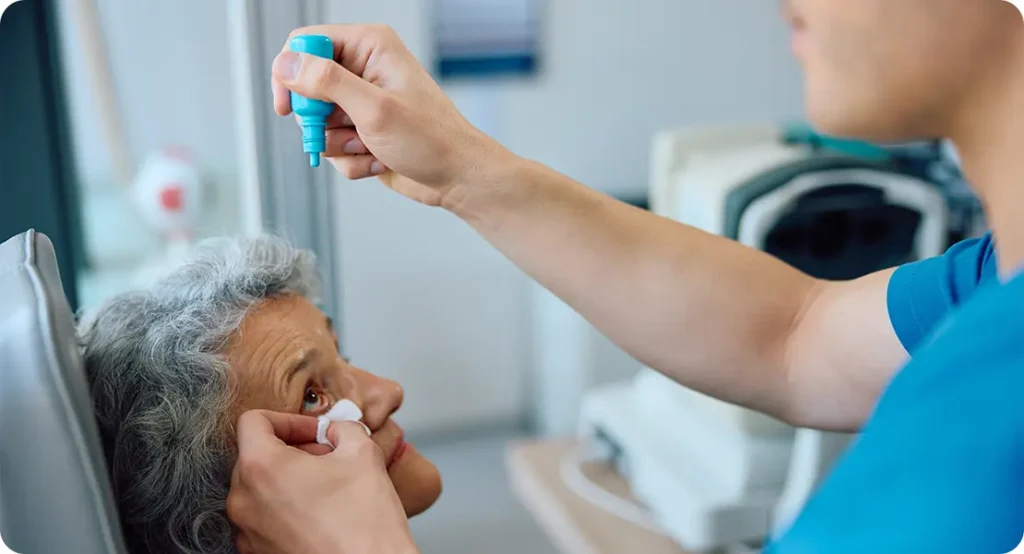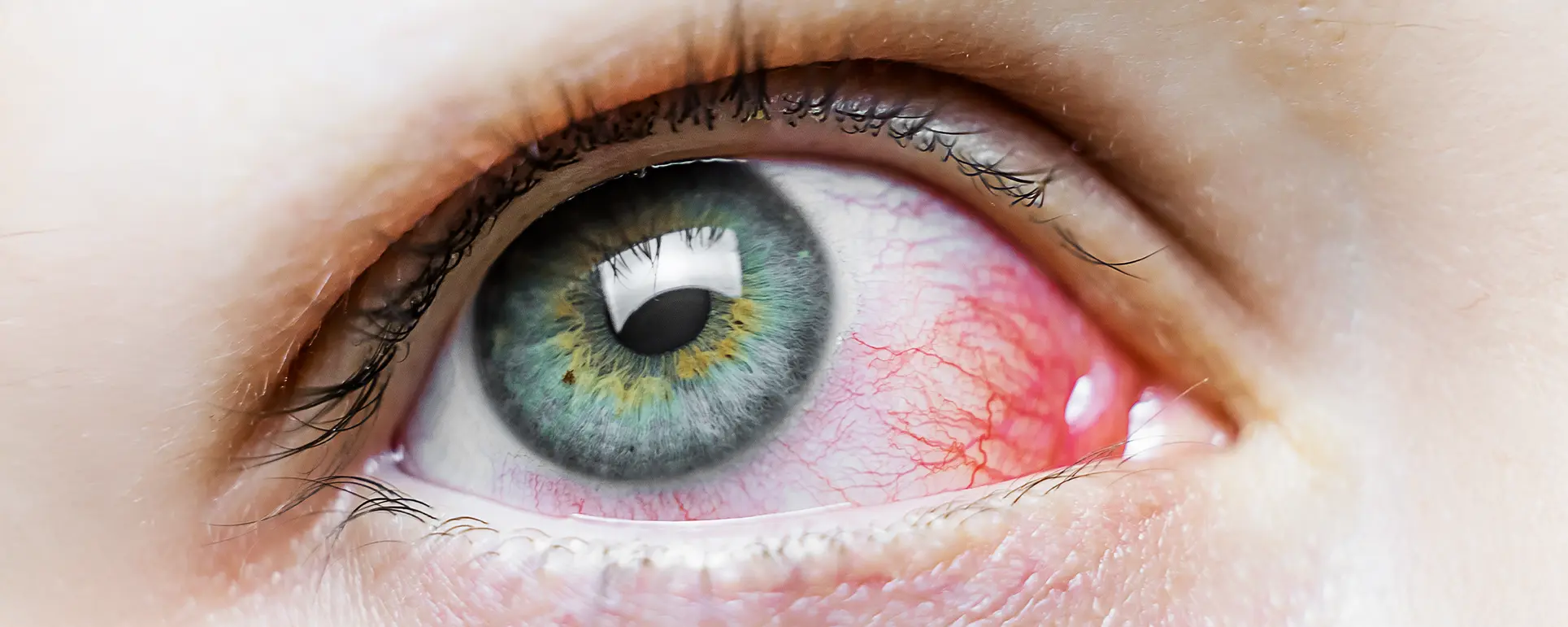If you’ve had cataract surgery and later needed a YAG laser capsulotomy, you may have found yourself asking a new question: why do my eyes feel dry and irritated now? While this treatment is highly effective for restoring clear vision by removing the cloudiness of posterior capsule opacification (PCO), it’s not uncommon for patients to report a gritty or uncomfortable feeling in the eyes afterwards. Some even worry that the laser has made their dry eyes worse or triggered new symptoms altogether.
In reality, the story is a bit more complex. YAG capsulotomy itself doesn’t directly cause dry eye disease, but the treatment process, temporary inflammation, and the natural history of eye health after cataract surgery can all contribute to sensations of dryness or irritation. The good news is that for most people, these symptoms are mild, short-lived, and easily managed with a few simple care steps.
In this article, we’ll explore the connection between YAG capsulotomy and dry eyes, why symptoms may appear or worsen, what to expect during recovery, and the practical ways you can keep your eyes comfortable. We’ll also cover the bigger picture of dry eye syndrome, so you understand how it fits into your overall eye health journey. Finally, you’ll find an FAQ section answering common concerns patients raise about dryness after YAG treatment.
What Exactly Is a YAG Capsulotomy?
After cataract surgery, the cloudy natural lens is replaced with a clear artificial intraocular lens (IOL). This new lens sits inside a thin, transparent structure called the posterior capsule. In many people, over months or years, this capsule becomes hazy due to natural cell growth, a condition called posterior capsule opacification. It’s sometimes nicknamed a “secondary cataract” because it causes blurred vision that feels similar to the original cataract.
A YAG laser capsulotomy is the standard treatment for PCO. In a quick outpatient procedure, an eye doctor uses a highly precise YAG laser to create a small opening in the cloudy capsule, allowing light to pass through clearly again. The result is usually rapid restoration of sharp vision, often within hours.
The treatment is safe, fast, and painless, but like any eye procedure, it can have side effects. Most are temporary, such as floaters or mild inflammation. Dryness or irritation falls into this category, but patients often wonder why it happens at all.
Why Do Some People Notice Dryness After YAG Capsulotomy?

There are several reasons why you might feel more dryness or irritation after the procedure. First, any laser treatment on the eye causes a very small degree of inflammation. Even though YAG capsulotomy doesn’t involve cutting or stitches, the energy from the laser still interacts with eye tissues. This can briefly disturb the tear film—the delicate layer of moisture that coats and protects your eye’s surface.
Second, the pupil is dilated before the procedure, and dilating drops themselves can temporarily disrupt tear stability. On top of this, the disinfecting solutions used before laser treatment may strip away some of the natural oils and mucins that help your tears spread evenly. For someone who already has a tendency towards dry eye, these factors can combine to make irritation more noticeable.
Finally, age itself plays a role. The majority of patients who undergo cataract surgery (and later YAG capsulotomy) are older adults, and dry eye syndrome is naturally more common with age. So it’s not that the YAG capsulotomy causes dry eyes in a permanent sense—it often just brings out a problem that was already there.
How Long Do Dry Eye Symptoms Usually Last After YAG?
The good news is that in most cases, any dryness or irritation after a YAG capsulotomy settles quickly. Some people feel scratchiness for just a few hours, while others may notice mild discomfort for a few days. It’s far less common for symptoms to last longer than a week or two.
If dryness continues, it’s usually because of an underlying dry eye condition that was present before the procedure but hadn’t been as noticeable. Once vision clears up after the laser, patients often become more aware of subtle issues like irritation, whereas before they were more focused on the blurring from PCO.
Persistent or severe dryness is a signal to talk to your eye doctor, who can check whether there’s an underlying dry eye problem that needs separate treatment.
The Role of Inflammation in Post-YAG Irritation
Inflammation is the body’s natural response to almost any kind of tissue stress. With YAG capsulotomy, the amount of inflammation is small, but it can still affect the surface of the eye. Inflammatory molecules temporarily change how well the tear film clings to the cornea. This leads to patches where the eye feels drier or more exposed.
This is why anti-inflammatory eye drops are often prescribed for a few days after the procedure. They don’t just calm the inside of the eye—they also help stabilise the surface, making it less likely that you’ll notice burning, stinging, or dryness.
Understanding that this irritation is usually the result of inflammation, not permanent damage, can be reassuring for patients worried that the laser has somehow harmed their tear glands.
How Your Tear Film Works and Why It Matters
To understand why the eye feels dry, it helps to look at the tear film itself. Far from being “just water,” your tears have three layers: an oily outer layer, a watery middle layer, and a mucous inner layer. Together, these spread smoothly across the cornea to keep it moist and protected.
When any part of this balance is disrupted—whether by age, inflammation, or environmental factors—the tear film becomes unstable. You may experience blurring, stinging, or a gritty sensation. After YAG treatment, the disruption is usually short-lived, but it can highlight existing weaknesses in the tear system, particularly the oil-producing glands in the eyelids.
That’s why lubricating drops, warm compresses, and sometimes dietary changes (like increasing omega-3 intake) are recommended for patients with ongoing dryness. Supporting the tear film is key to restoring comfort.
Eye Drops and Treatments That Help After YAG Capsulotomy

One of the simplest ways to relieve irritation after a YAG capsulotomy is with artificial tears. These lubricating drops supplement the natural tear film and provide a smooth surface for the eye while healing settles. Preservative-free formulas are usually recommended, as preservatives themselves can sometimes worsen irritation if used too often.
Other supportive treatments include warm compresses to improve oil gland function, lid hygiene to reduce inflammation along the lash line, and short courses of anti-inflammatory drops prescribed by your doctor. In more persistent cases, treatments like punctal plugs (which help retain tears on the eye’s surface for longer) may be considered.
The choice of treatment depends on whether your symptoms are mild and temporary, or whether they point to a longer-term dry eye condition.
Lifestyle Tips to Keep Dry Eyes Under Control After Laser Treatment
Simple lifestyle habits can make a big difference if you find yourself struggling with dryness after YAG capsulotomy. Staying well-hydrated, using a humidifier in dry environments, and taking regular breaks from screens can all help reduce eye strain and dryness. Blinking consciously—especially when reading or working on a computer—also helps restore tear film balance.
Wearing sunglasses outdoors not only protects from UV rays but also shields against wind and dust, both of which can aggravate dry eyes. A balanced diet rich in omega-3 fatty acids, found in oily fish like salmon or supplements such as flaxseed oil, can also support healthy tear production.
These steps won’t replace medical treatments if you have significant dry eye disease, but they are excellent add-ons that make day-to-day comfort much easier to achieve.
When Should You Be Concerned About Dry Eyes After YAG?
While most post-YAG dryness is mild, there are times when you should seek further advice. If your eyes are red, painful, or unusually sensitive to light, it could indicate inflammation that needs prescription treatment. If dryness persists beyond a couple of weeks, it’s also worth getting checked to rule out underlying dry eye syndrome or other eye surface conditions.
Another important point is vision. If you notice increasing blur, new floaters, or flashes of light, these aren’t typical signs of dry eye—they may suggest a different issue, such as retinal changes. In that situation, contact your eye specialist promptly.
FAQs About YAG Capsulotomy and Dry Eyes
1. Can YAG capsulotomy cause permanent dry eyes?
No, YAG capsulotomy does not cause permanent dry eyes. The laser energy is focused only on the posterior capsule of the lens, well away from the tear glands and the surface structures that control moisture. Any dryness people notice after treatment is usually due to temporary irritation, inflammation, or the effects of dilating drops used beforehand. For those who already had dry eye tendencies, the procedure can make them more noticeable, but the laser itself does not permanently damage the tear system.
2. Why do my eyes feel gritty after YAG treatment?
The gritty sensation often comes from a temporary imbalance in the tear film. Dilating drops and antiseptic solutions used during the procedure can wash away some of the oils and mucins that normally help tears spread evenly across the surface of the eye. As a result, the cornea may feel dry or sandy for a short period. Artificial tears can usually restore comfort, and the sensation tends to fade as the tear film stabilises again over the following days.
3. How long will dryness last after my YAG capsulotomy?
For most people, dryness or irritation only lasts a few hours to a few days. In some cases, it may linger for a week or two, particularly in patients who already had mild or moderate dry eye disease before treatment. If symptoms continue beyond this period, it is usually a sign that an underlying dry eye condition is present rather than something directly caused by the laser. That’s why it’s a good idea to discuss ongoing dryness with your eye doctor, who can suggest tailored treatment.
4. Do dilating drops make dry eyes worse?
Yes, they can temporarily contribute to dry eye symptoms. Dilating drops change the size of the pupil and alter the natural balance of the eye’s surface. In addition, the preservatives in some dilating drops can briefly irritate the delicate cells on the cornea. For someone with a history of dry eye, this can feel more noticeable. Fortunately, the effect wears off within hours, and using preservative-free lubricating drops afterwards usually helps restore comfort quickly.
5. Should I use lubricating drops after YAG capsulotomy?
Yes, lubricating drops are one of the easiest and most effective ways to soothe the eyes after a YAG capsulotomy. Preservative-free artificial tears provide a smooth coating on the cornea, reducing friction and irritation while the eye adjusts after the procedure. Even if dryness is mild, regular use of these drops in the days following treatment can speed up recovery and make you feel more comfortable. For many patients, this is all that is needed to relieve post-laser irritation.
6. Could my age make dry eyes worse after YAG?
Age is a major factor in dry eye disease, and most people who undergo cataract surgery and later need a YAG capsulotomy are in their sixties, seventies, or older. Tear production naturally decreases with age, and the oil glands in the eyelids may not work as effectively. This means that even if the laser treatment does not directly cause dryness, older patients are more likely to experience it. Recognising this overlap is important, as it helps explain why symptoms are common but not usually serious.
7. Can lifestyle changes really help with dryness?
Yes, lifestyle changes can make a noticeable difference, especially after YAG capsulotomy when the eye is temporarily more sensitive. Staying hydrated, avoiding overly dry environments, and reducing screen time can all support tear stability. Simple steps like blinking more often while reading or working on a computer also help prevent the eyes from drying out. Wearing wraparound sunglasses outdoors can protect against wind and sun, both of which can aggravate dry eye symptoms. These small adjustments often add up to much better comfort.
8. Are there prescription treatments for persistent dryness?
Yes, if over-the-counter drops don’t fully relieve your symptoms, your eye doctor may recommend prescription treatments. These can include short courses of anti-inflammatory drops to calm the surface of the eye, or in some cases punctal plugs that help keep tears on the eye for longer. More advanced options, such as ciclosporin or lifitegrast drops, may be considered for long-term management of significant dry eye disease. These treatments are not needed for everyone but are helpful if symptoms don’t settle with basic care.
9. What’s the difference between dry eyes and other post-YAG issues like floaters?
Dry eyes and floaters are two very different things, though both may appear after YAG capsulotomy. Dry eyes cause discomfort, burning, or a sandy feeling due to an unstable tear film, while floaters look like small specks or cobwebs drifting across your vision. Floaters are caused by changes in the vitreous gel inside the eye, not by the surface moisture. Understanding this difference helps you and your doctor determine whether your symptoms are related to the tear film or the inner eye structures.
10. When should I worry about post-YAG dryness?
You should seek medical advice if dryness becomes severe, does not improve with lubricating drops, or continues beyond two weeks. Redness, significant pain, or sensitivity to light are also warning signs that something more than simple dryness may be happening, such as inflammation or infection. Additionally, if your vision becomes blurry again, or you notice flashes of light or a sudden shower of floaters, this is not related to dryness and should be checked urgently. Being aware of these red flags helps you stay safe after your procedure.
Final Thoughts
YAG capsulotomy is a safe and highly effective way of restoring vision after posterior capsule opacification, but it can sometimes leave patients with mild feelings of dryness or irritation. This usually happens because of temporary inflammation, dilating drops, or pre-existing dry eye issues that become more noticeable after the procedure.
For most people, symptoms are short-lived and improve quickly with the help of lubricating drops, simple lifestyle adjustments, and occasionally prescription treatments. The key is to understand that YAG capsulotomy itself does not permanently damage your tear system—it simply interacts with an eye that may already be prone to dryness due to age or other factors.
If you’re preparing for YAG capsulotomy or dealing with dryness afterwards, remember that support is available. A tailored approach, guided by your eye doctor, can help keep your vision clear and your eyes comfortable. And if you’d like to learn more about your options for cataract surgery and aftercare, you can visit the London Cataract Centre for expert guidance and treatment.
Here are five Harvard-style references with working URLs to support your article on YAG capsulotomy and dry eyes. Each citation is relevant, authoritative, and helps strengthen the depth of your content:
References
- Kasetsuwan, N., Satitpitakul, V., Changul, T. & Jariyakosol, S. (2013) Incidence and pattern of dry eye after phacoemulsification, PLoS ONE, 8(11), e78657. doi:10.1371/journal.pone.0078657. Available at: https://doi.org/10.1371/journal.pone.0078657
- Mencucci, R. et al. (2021) Iatrogenic dry eye disease: Dealing with the conundrum of post‑cataract discomfort — A P.I.C.A.S.S.O. board narrative review, Ophthalmology and Therapy, (year). Available at: https://link.springer.com/article/10.1007/s40123-021-00332-7
- Ta, H. (2025) Dry eye post‑cataract surgery: a systematic review and meta-analysis, BMC Ophthalmology, (year). Available at: https://bmcophthalmol.biomedcentral.com/articles/10.1186/s12886-024-03841-8
- Lee, C.-Y., Yang, S.-F., Chen, Y.-C. & Chang, C.-K. (2025) The duration of cataract surgery and the change in postoperative dry eye disease parameters: A retrospective cohort study, Diagnostics, 15(3), 330. doi:10.3390/diagnostics15030330. Available at: https://doi.org/10.3390/diagnostics15030330
- Donthineni, P.R. et al. (2023) Management of cataract in dry eye disease: Preferred practice patterns, Indian Journal of Ophthalmology, (year). Available at: https://journals.lww.com/ijo/fulltext/2023/04000/management_of_cataract_in_dry_eye_disease_.40.aspx

